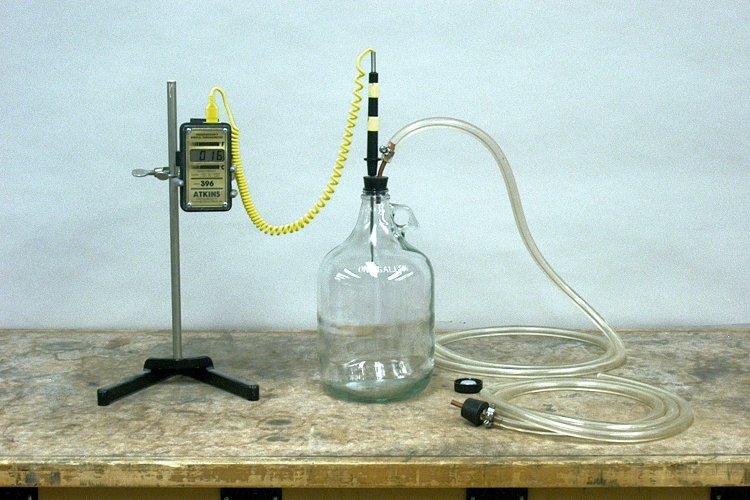
Pour 100 mL of water into the one gallon bottle. Cap the bottle and allow it to sit long enough that the water vapor can fill the bottle uniformly, perhaps about ten minutes. (Swirling the water around the sides of the bottle should help.) Uncap the bottle and push the stopper into the bottle opening. With the other end of the Tygon® tubing attached to an air spigot, turn the valve a small amount. The pressure inside the bottle will gradually build until the stopper pops off. The sudden change in pressure allows the gas in the bottle to expand rapidly and, thus, adiabatically. The gas in the bottle thus cools, condensing the water vapor and filling the bottle with fog. Alternatively, you can hold the stopper on the bottle, open the valve to pressurize the bottle, close the valve, and then suddenly release the stopper (vide infra).
If you would like merely to show the fog that forms when the gas inside the bottle expands and cools, and that it goes away when you pressurize the bottle again, you can use the single-hole stopper and length of tubing shown in the foreground at right in the photograph above. If you wish to show the changes in temperature that occur when you compress the gas and then allow it to expand, you can use the two-hole stopper with its tubing, shown inserted in the neck of the bottle in the photograph. A thermocouple probe inserted into the free hole in the stopper allows you to measure the temperature within the bottle. (Thanks go to Prof. Jim Allen, who suggested the idea of measuring the temperature inside the bottle.) The temperature changes are great enough that the thermocouple can clearly register them. You can project the themocouple readout by means of a video camera, so that the whole class can see it. Alternatively, there is now available a thermocouple controller whose output you can display on a laptop PC via a LabView program, the image of which you can send to the projector.
Whichever setup you use (with or without thermocouple probe), you have two choices for compressing the gas and then letting it expand. If you choose the method of opening the valve slightly and letting the stopper pop out on its own, as described above, you must open the valve only the slightest bit. The time between when the valve is opened and the stopper pops off should be about 40 seconds to 1 minute (1 minute is probably a bit better). With air flows that give such filling/bursting times, you will see a slight rippling in the surface of the water. If the bottle has been filling for longer than a minute and the stopper has not popped, if there really has been air flow, then you can pull the stopper off suddenly and the bottle will fill with fog. The setting on the regulator for the air supply is not critical, but 50 psig works well. (The setting merely has to be high enough to provide the bursting pressure.)
While the above procedure is somewhat dramatic, there is a quicker — and possibly more effective — way to perform this demonstration. If you wish, you can hold the stopper in the neck of the bottle, then open the valve wide, so that the bottle fills quickly. Close the valve and then release the stopper so that it pops off suddenly, and the bottle will fill with fog.
The demonstration can be repeated immediately, because as soon as you begin to pressurize the bottle for the next run, the fog clears.